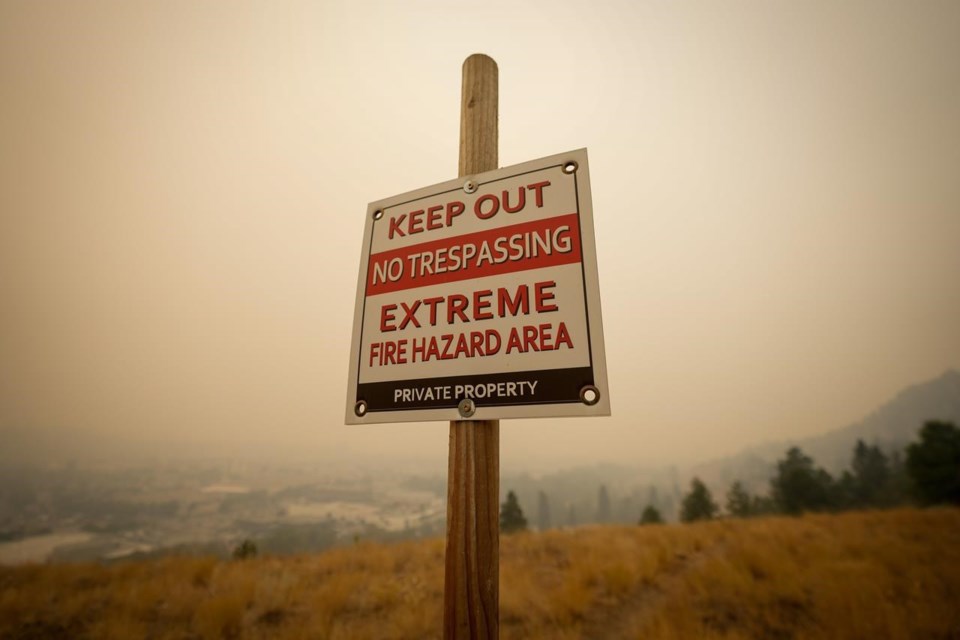Lightning strikes have sparked dozens of new wildfires in British Columbia, as thunderstorms brought mixed blessings to the province's battle against its worst fire season on record.
A forecast of rain promised relief for some wildfire zones in the south and Interior, but lightning associated with the storms triggered most of the 47 new blazes recorded in the past day, pushing the total number of fires in the province above 400 on Tuesday.
Thirty-seven lightning-caused fires started in the Coastal fire region, including Vancouver Island, but there were also new lightning-related blazes in the Kamloops and Prince George regions.
Some much-needed rain fell on the island, with almost two millimetres recorded at Victoria's airport, but the BC Wildfire Service had warned on social media that lightning associated with a severe thunderstorm event over the island Monday night risked setting fires.
Meanwhile, crews battling a destructive wildfire in the Shuswap region in the Interior hoped for help from the rain.
Tim Conrad, an information officer with the Columbia Shuswap emergency operations centre, told a briefing Tuesday that increased fire activity associated with warm weather was "a blip."
Temperatures in Salmon Arm and Kelowna both breached 30 C on Monday with no precipitation recorded.
But Conrad said better firefighting conditions were on the way.
Mike McCulley, an information officer with the BC Wildfire Service, said Tuesday was a "day of change" for the Bush Creek East wildfire.
McCulley said winds may increase fire activity but he didn't expect to see growth of the fire, which is about 430 square kilometres in size.
There was hope for rain in the evening as crews are "consolidated" around "high-value communities," he said.
The fire, which destroyed or significantly damaged nearly 170 properties just over a week ago, is now being tackled by a 300-strong groundcrew. It includes some local residents recruited to fight the fire as well as a team of South African firefighters.
McCulley said there are 80 pieces of heavy equipment aiding the fire fight as well.
Derek Sutherland, director of the emergency operations centre for the Columbia Shuswap Regional District, said Tuesday that a process has begun to notify residents whose properties have been affected by the wildfire.
Sutherland urged residents to reach out to the centre if they wanted to discuss their properties.
"If need be, we can put them to the top of the list and get them their phone call so we can discuss next steps," he said.
Both Sutherland and public information officer Tim Conrad said BC Hydro crews were working to get power restored after hundreds of power poles were damaged by flames.
"It's a significant amount of damage," Conrad said. "It's the kind of level that you usually hear in relation to a hurricane, not a wildfire."
Elsewhere in the province, wildfire activity continues to affect road travel, including a closure of Highway 37 near the Yukon boundary.
But the province said Tuesday that Highway 1 between Boston Bar and Lytton is now reopened after being closed due to the Kookipi Creek wildfire in the Fraser Canyon.
In the Okanagan, while many evacuation orders in the beleaguered city of West Kelowna have been downgraded to alerts, Central Okanagan Emergency Operations said Tuesday that properties north of Highway 97 in the Westbank First Nation are being added to an existing evacuation order.
Emergency officials in the region said increased winds are elevating fire risk, and fire crews in West Kelowna are being aided by trucks from neighbouring communities from Armstrong to Peachland.
The winds resulted in the expansion of an evacuation alert in West Kelowna to include all of the Glenrosa and Westbank neighbourhoods.
There were 417 wildfires burning in B.C. Tuesday afternoon, including 197 classified as out of control and 12 "wildfires of note," meaning they're highly visible or pose a threat to public safety.
Large portions of northeastern B.C. continued to swelter Tuesday, a day after some areas hit daily record temperatures.
The BC Wildfire Service had cautioned that warm, dry conditions in northern parts of the province would see increased fire activity in the region, with the Fort Nelson First Nation putting two reserves on alert.
Environment Canada said Tuesday temperatures were again pushing near or past 30 C in parts of the Peace River Regional District and the Northern Rockies Regional Municipality.
A heat warning for northeastern B.C. was expected to be in place until the evening, while another warning for the North Coast District, including Terrace and Kitimat, was lifted.
Historic records for daily high temperatures for Aug. 28 were broken Monday in Fort St. John, Dawson Creek and Fort Nelson.
Fort Nelson reached 33.9 C, almost six degrees higher than the previous record for that day recorded in 1986.
Steady rain was falling over Metro Vancouver on Tuesday, leading to the cancellation of the air quality advisory that had been in effect over much of the Lower Mainland since last Friday.
This report by The Canadian Press was first published Aug. 29, 2023.
The Canadian Press



